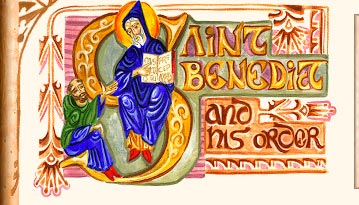Tags
Benedictine Monks, Canonical Hours, Divine Office, Gregorian chant, Hendrik Vanden Abeele, Liber Usualis, Psallentes, Saint Benedict of Nursia
In the Rule of Benedict, Benedict of Nursia (c. 480 – 543 or 547) stated that, “As the prophet saith:”
Seven times a day I have given praise to Thee” (Ps 118[119]: 164), this sacred sevenfold number will be fulfilled by us in this wise if we perform the duties of our service at the time of Laud, Prime, Tierce, Sext, None, Vespers, and Compline; because it was of these day hours that he had said: “Seven times a day I have given praise to Thee” (Ps 118[119]: 164). For the same prophet saith of the night watches: “At midnight I arose to confess to Thee” (Ps118[119]:62 )[i]
Benedict of Nursia is considered the father of medieval monasticism and, during the above-named Canonical Hours, Cenobite Benedictine Monks (monks who lived under the rule of an abbey) sung psalms using Gregorian chant. Gregorian chant is named after Pope Gregory I (c. 540 – 12 March 604), but it was not fully codified until the monks of Solesmes undertook this task, in the nineteenth-century.
The monastery at Solesmes, France, had been lost to civilians during the French Revolution (1789 – c. 1794). It was restored and the liturgical Gregorian chants, now contained in the Liber usualis, were edited. However, Gregorian chant had nevertheless been used since the eight century. In the Rule of Benedict (XIX), Benedict writes: “Sing ye wisely” (Ps 46[47]:8). In Chapter IX of his Rule, we find a reference to a “cantor,”[ii] a Judaic term.
The Liber Usualis as Book of Hours
In other words, the Benedictine’s Book of Hours is the above-mentioned Liber Usualis, a compendium of liturgical Gregorian chants, first edited in 1896 by Solesmes abbot Dom André Mocquereau (1849–1930). The Canonical Hours are also called the Divine Office and Liturgy of the Hours.
Here are the Canonical Hours still observed by Benedictine monks. Benedict added an eight hour to the prophet’s seven:
- Matins (during the night, at midnight with some), sometimes referred to as Vigils or Nocturns, or in monastic usage the Night Office; in the Breviary of Paul VI it has been replaced by the Office of Readings
- Lauds or Dawn Prayer (at Dawn, or 3 a.m.)
- Prime or Early Morning Prayer (First Hour = approximately 6 a.m.)
- Terce or Mid-Morning Prayer (Third Hour = approximately 9 a.m.)
- Sext or Midday Prayer (Sixth Hour = approximately 12 noon)
- None or Mid-Afternoon Prayer (Ninth Hour = approximately 3 p.m.)
- Vespers or Evening Prayer (“at the lighting of the lamps”, generally at 6 p.m.)
- Compline or Night Prayer (before retiring, generally at 9 p.m.)*
*in Wikipedia
Gregorian Chant
Incipit of the standard Gregorian chant setting
of the Asperges, from the Liber Usualis.
Although it is a Book of Hours, the Liber Usualis is not an illuminated manuscript, except for historiated initials. Despite a motivation, by the monks of Solesmes, to revive Benedictine monasticism, it is a modern book of Gregorian Chant. However, in the wake of its publication, a Motu Propio (letter from the Pope) for the reform of Church music was issued by pope Pius X (22 November 1903), approving of the Liber Usualis. It should also be noted that the Second Vatican Ecumenical Council (opened by Pope John XXIII in 1962) retained Gregorian chant (Sacrosanctum Concilium, 116). So, although Monks now use the Liber Usualis, Gregorian chant has never fallen into obsolescence.
—ooo—
In earlier posts, I have stated that feasts were celebrated during solstices and equinoctial points and that consequently the transition between “paganism” and Christianity had not been abrupt. Similarly, Benedictine Hours are related to solstices and equinoxes.
However, the Hours are also rooted in the concept of vigilance. When Christ was taken prisoner by the Romans, he had been betrayed by Judas, his disciples would not keeping vigil with him. Christ was abandoned in the Garden of Gethsemane. Moreover, according to Matthew 27:45-46, when he was dying on the cross, at about the ninth hour Jesus cried, Eli, Eli, lama sabachthani? (Aramaic): “My God, my God, why hast thou forsaken me?”
Critic Northrop Frye suggests that these words: “My God, my God, why hast thou forsaken me?” express the very essence of the tragic mode.
a sense of his exclusion, as a divine being, from the society of the Trinity.[iii]
RELATED ARTICLE
- Mostly Misericords: the Medieval Bestiary (10 November 2014)
Sources and Resources
- Rule of Saint Benedict (oll.libertyfund.org/titles/2202) (EN)
- La Règle de Saint Benoît (FR)
- La Regla de San Benito (SP)
- Liber usualis (PDF)
[i] See Chapter XVI of the Rule of Saint Benedict.
[ii] Shebbeare, Wilfrid. “Cantor.” The Catholic Encyclopedia. Vol. 3. New York: Robert Appleton Company, 1908. 7 Dec. 2012.
http://www.newadvent.org/cathen/03306a.htm
[iii] Northrop Frye, Anatomy of Criticism (Princeton, N. J.: Princeton University Press, 1957), p. 36.






Computers are not perfect. They also play tricks on me. Best MW
LikeLike
I wish I knew. How does one even know that one’s material is being copied? It is so complicated. I wish you the best. MW
LikeLike
Thank you. Best regards, MW
LikeLike
I’m no chant expert but it soduns like Gregorian Chant to me. I looked up the definition and this is what I found: “plainsong, plainchant, a repetitive song in which as many syllables as necessary are assigned to a single tone.”Sure comes a lot closer to Gregorian Chant than Gather Us In. And I’m all for Latin, but if you can accustomize those prejudiced against it by beginning with this, I’m all for it!
LikeLike
Thank you.
I do research my posts and try to be absolutely accurate.
Do come back.
Best,
Micheline
LikeLike